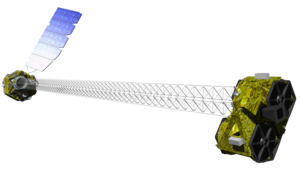
Back نوستار Arabic NuSTAR Byelorussian NuSTAR Catalan NuSTAR Czech Nuclear Spectroscopic Telescope Array German NuSTAR Spanish نیوستار Persian NuSTAR Finnish Nuclear Spectroscopic Telescope Array French NuSTAR Galician
 NuSTAR (Explorer 93) satellite | |
| Names | Explorer 93 Nuclear Spectroscopic Telescope Array SMEX-11 |
|---|---|
| Mission type | X-ray astronomy |
| Operator | NASA / JPL |
| COSPAR ID | 2012-031A |
| SATCAT no. | 38358 |
| Website | www |
| Mission duration | 2 years (planned) 11 years, 11 months, 5 days (in progress) |
| Spacecraft properties | |
| Spacecraft | Explorer XCIII |
| Spacecraft type | Nuclear Spectroscopic Telescope Array |
| Bus | LEOStar-2 |
| Manufacturer | Orbital Sciences Corporation ATK Space Components |
| Launch mass | 350 kg (770 lb)[1] |
| Payload mass | 171 kg (377 lb) |
| Dimensions | 1.2 × 10.9 m (3 ft 11 in × 35 ft 9 in) |
| Power | 750 watts[2] |
| Start of mission | |
| Launch date | 13 June 2012, 16:00:37 UTC[3] |
| Rocket | Pegasus XL (F41) |
| Launch site | Kwajalein Atoll, Stargazer |
| Contractor | Orbital Sciences Corporation |
| Orbital parameters | |
| Reference system | Geocentric orbit |
| Regime | Near-equatorial orbit |
| Perigee altitude | 596.6 km (370.7 mi) |
| Apogee altitude | 612.6 km (380.7 mi) |
| Inclination | 6.027° |
| Period | 96.8 minutes |
| Main telescope | |
| Type | Wolter type I |
| Focal length | 10.15 m (33.3 ft)[2] |
| Collecting area | 9 keV: 847 cm2 (131.3 sq in) 78 keV: 60 cm2 (9.3 sq in) |
| Wavelengths | 3–79 keV |
| Resolution | 9.5 arcseconds |
| Instruments | |
| Dual X-ray telescope | |
Explorer program | |
NuSTAR (Nuclear Spectroscopic Telescope Array, also named Explorer 93 and SMEX-11) is a NASA space-based X-ray telescope that uses a conical approximation to a Wolter telescope to focus high energy X-rays from astrophysical sources, especially for nuclear spectroscopy, and operates in the range of 3 to 79 keV.[4]
NuSTAR is the eleventh mission of NASA's Small Explorer (SMEX-11) satellite program and the first space-based direct-imaging X-ray telescope at energies beyond those of the Chandra X-ray Observatory and XMM-Newton. It was successfully launched on 13 June 2012, having previously been delayed from 21 March 2012 due to software issues with the launch vehicle.[5][6]
The mission's primary scientific goals are to conduct a deep survey for black holes a billion times more massive than the Sun, to investigate how particles are accelerated to very high energy in active galaxies, and to understand how the elements are created in the explosions of massive stars by imaging supernova remnants.
Having completed a two-year primary mission,[7] NuSTAR is in its eleventh year of operation.
- ^ "Nuclear Spectroscopic Telescope Array (NuSTAR)" (PDF). Jet Propulsion Laboratory. June 2012. Retrieved 16 June 2012.
- ^ a b "NuSTAR (Nuclear Spectroscopic Telescope Array)". European Space Agency. Retrieved 2 July 2015.
- ^ Ray, Justin. "Mission Status Center". Spaceflight Now. Retrieved 13 June 2012.
- ^ "About". NuSTAR. Caltech. Retrieved 15 October 2017.
- ^ "Launch of NASA's NuSTAR Mission Postponed". NASA. 16 March 2012. Retrieved 15 October 2017.
 This article incorporates text from this source, which is in the public domain.
This article incorporates text from this source, which is in the public domain.
- ^ "NASA Selects Explorer Mission Proposals for Feasibility Studies (03-353)" (Press release).
 This article incorporates text from this source, which is in the public domain.
This article incorporates text from this source, which is in the public domain.
- ^ Presto, Suzanne (13 August 2014). "Black hole bends light, space, time – and NASA's NuSTAR can see it all unfold". CNN Business. CNN. Retrieved 28 November 2022.
© MMXXIII Rich X Search. We shall prevail. All rights reserved. Rich X Search